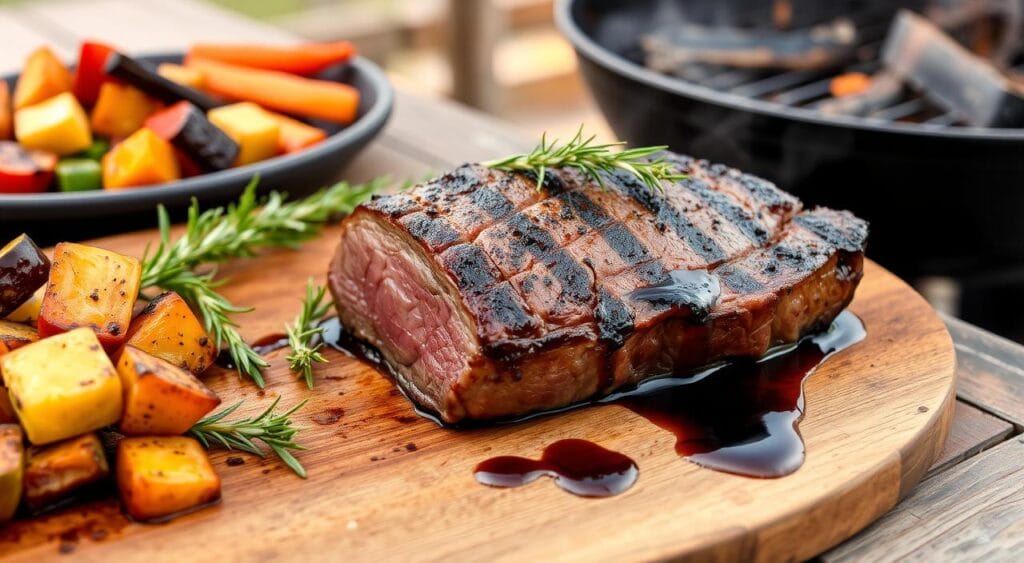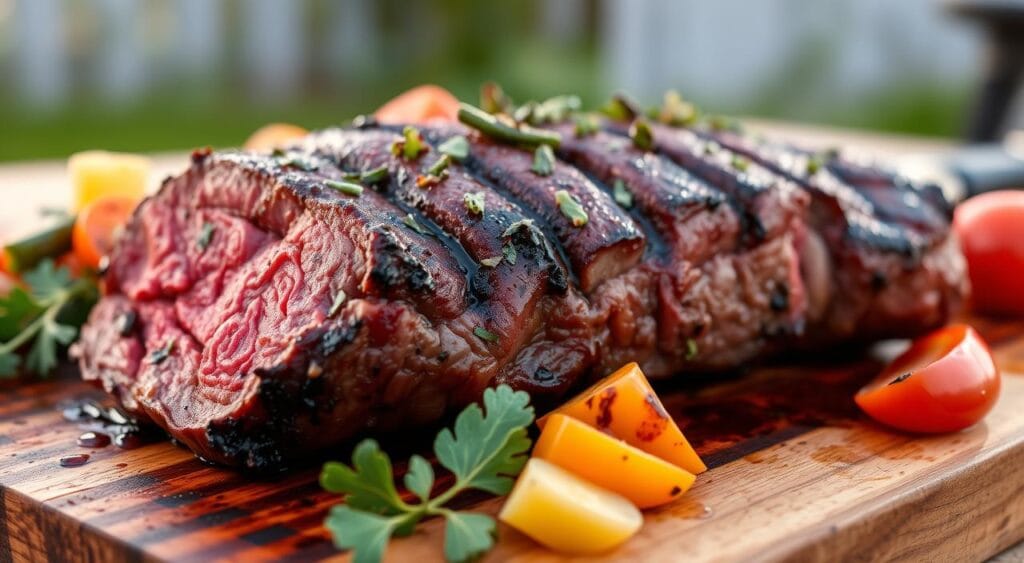Table of Contents
I love cooking venison dishes and hunting in the forest. The taste of deer meat reminds me of those peaceful moments. Today, I want to share some tasty venison tenderloin steak recipes with you.
Tenderloin is the best part of venison, known for its tender and lean texture. These recipes will help you make this premium ingredient into a dish you’ll love.
These recipes include pan-seared and herb-crusted steaks. You’ll learn different ways to cook and flavor your venison. We’ll also talk about the best sides and sauces to go with it.
Are you ready to try some delicious venison tenderloin recipes? Let’s start our culinary journey with venison tenderloin steak recipes that will become your favorites.
Key Takeaways
- Venison tenderloin is a premium, tender cut of deer meat that can be prepared in various delicious ways.
- This article covers expert cooking techniques, marinades, and side dishes to help you create flavorful venison steaks.
- Explore a range of mouthwatering venison tenderloin steak recipes, from classic pan-seared to herb-crusted grilled options.
- Discover the importance of proper storage, preparation, and cooking methods to ensure your venison tenderloin is cooked to perfection.
- Learn how to pair your venison steaks with the right accompaniments, including sauces and side dishes, to elevate the overall dining experience.
Understanding Venison Tenderloin: From Field to Table
Venison, the meat from wild deer, is a delicacy known for its rich flavor and lean texture. The tenderloin, a premium cut, is both tender and versatile. Knowing the anatomy of deer and how to handle this wild meat is key to enjoying it in the kitchen.
Identifying Premium Cuts of Deer Meat
The tenderloin and backstrap are the most sought-after cuts of venison. The tenderloin, or loin steak, is a long, slender muscle along the spine. It’s exceptionally tender and lean because it’s used less. The backstrap, running along the spine, is a bit more robust and has a more pronounced flavor.
Proper Storage and Preparation Methods
Keeping wild meat fresh requires careful storage and preparation. Venison should be refrigerated or frozen right after field dressing. When cooking, thaw it slowly in the fridge to keep its texture delicate. Trimming off silver skin and connective tissue also improves tenderness and flavor.
The Difference Between Backstrap and Tenderloin
- Tenderloin: A long, slender muscle along the spine, known for its exceptional tenderness and lean texture.
- Backstrap: A muscle along the spine, offering a more pronounced wild meat flavor and a slightly firmer texture.
Knowing the unique traits of these cuts helps you choose and prepare venison for your dishes.
Essential Tools and Ingredients for Perfect Venison Steaks
To make delicious grilled venison steaks at home, you need more than just good meat. You’ll also need the right tools and ingredients. This includes the perfect venison marinade and cooking gear. Let’s look at what you need to make venison dishes that taste like they’re from a restaurant.
Marinades and Seasonings
A tasty grilled venison steak begins with a great marinade. Choose marinades with wine or vinegar, herbs, spices, and aromatics. Venison’s unique taste goes well with earthy flavors like rosemary, thyme, garlic, and black pepper. Marinating your steaks makes them juicy and tender when grilled.
Cooking Equipment
- A sturdy, cast-iron grill pan or skillet for searing
- A meat thermometer to monitor doneness
- Sharp knives for trimming and slicing the venison
- Tongs and a spatula for effortless handling
- A basting brush for applying marinades and sauces
With the right tools and ingredients, you can make grilled venison steaks that are as good as those in steakhouses. Always handle wild game carefully and follow food safety rules for a tasty and healthy meal.

“The secret to perfectly cooked venison is all in the preparation. Take the time to marinate and season your steaks, and you’ll be rewarded with a juicy, flavorful meal that’s sure to impress.”
Best Venison Tenderloin Steak Recipes
Discover the secret to mouthwatering deer tenderloin steaks with these delectable recipes. Whether you prefer a classic pan-seared preparation, an herb-crusted grilled tenderloin, or a rich wine-braised wild game dish, we’ve got you covered. Elevate your deer tenderloin experience with these easy-to-follow, flavor-packed techniques.
Classic Pan-Seared Venison
For a simple yet impressive wild meat dish, try our pan-seared venison tenderloin. Season the meat with salt and pepper, then sear it in a hot cast-iron skillet until a perfect golden-brown crust forms. Finish in the oven for a juicy, medium-rare center. Drizzle with a bit of your favorite sauce or compound butter for an extra layer of flavor.
Herb-Crusted Grilled Tenderloin
Elevate your grilled venison with a flavorful herb crust. Rub the tenderloin with a blend of chopped fresh herbs, garlic, and olive oil, then grill over high heat until charred on the outside and tender inside. Serve with roasted vegetables and a glass of bold red wine for a truly gourmet meal.
Wine-Braised Wild Game Steaks
For a rich, fall-off-the-bone tenderness, braise your deer tenderloin in a flavorful red wine sauce. Sear the meat first to lock in the juices, then simmer it in a blend of red wine, stock, and aromatic vegetables until the meat is fork-tender. Serve over creamy mashed potatoes or buttered noodles for a comforting, restaurant-worthy dish.
| Recipe | Preparation Time | Cooking Time | Difficulty Level |
|---|---|---|---|
| Classic Pan-Seared Venison | 10 minutes | 20 minutes | Easy |
| Herb-Crusted Grilled Tenderloin | 15 minutes | 25 minutes | Moderate |
| Wine-Braised Wild Game Steaks | 20 minutes | 1 hour 30 minutes | Intermediate |

“Venison tenderloin is a true delicacy, with a rich, full-bodied flavor that pairs beautifully with a variety of seasonings and cooking methods.”
Temperature Guide and Cooking Techniques
Getting the perfect doneness for your venison tenderloin steak is key. Start by knowing the ideal internal temperature points. For a rare steak, aim for 120-125°F, medium-rare at 130-135°F, and medium at 140-145°F. Don’t overcook, as venison can dry out and become tough if cooked too long.
Ideal Internal Temperature Points
Use a reliable meat thermometer to check your desired doneness. Stick the thermometer into the thickest part of the steak, avoiding bones or gristle. This gives you an accurate reading. Remember, the temperature will rise a bit as the steak rests.
Resting and Serving Tips
Let your venison tenderloin steak rest for 5-10 minutes after cooking. This lets the juices spread, making it more flavorful and tender. When you serve, slice the steak against the grain for extra tenderness.
Avoiding Common Cooking Mistakes
To avoid common mistakes, don’t overcrowd the pan or grill. This can make the steak steam instead of sear. Also, don’t flip or poke the steak too much, as it loses juices. Finally, season your venison well with salt and pepper to bring out its natural flavors.
FAQ
What is the best way to cook venison tenderloin steaks?
You can cook venison tenderloin steaks by pan-searing, grilling, or braising. The most important thing is not to overcook it. This keeps the meat tender and flavorful. Try different marinades and seasonings to bring out the venison’s natural taste.
How do I identify a high-quality venison tenderloin?
A good venison tenderloin is firm, fine-grained, and deep red. Stay away from meat that looks dry, discolored, or smells bad. Buying from local or specialty butchers can help ensure freshness and quality.
What’s the difference between venison backstrap and tenderloin?
Both backstrap and tenderloin are top cuts of venison. The backstrap is a long, thin muscle along the spine. The tenderloin is smaller and more tender, under the backbone. Both are great for grilling, pan-searing, or braising.
How should I store and prepare venison tenderloin before cooking?
Store venison tenderloin in the coldest part of your fridge for 3-5 days. Before cooking, pat it dry, season well, and let it come to room temperature. Letting it rest after cooking helps keep it juicy and tender.
What are some common mistakes to avoid when cooking venison tenderloin?
Don’t overcook the venison, as it can become tough and dry. Also, make sure to let it rest before slicing. Avoid using high heat for too long, as it can char the outside before the inside is cooked. Keep an eye on the internal temperature and resting times for perfectly cooked venison.

